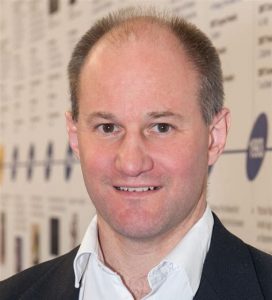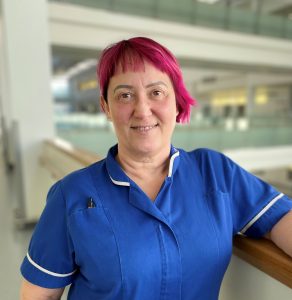Specialists in Newcastle are celebrating the 10 year anniversary of setting up a revolutionary lifesaving service in less than two weeks.
The Great North Children’s Hospital is internationally renowned for giving hope to hundreds of children with immunodeficiency, haematology and oncology disorders.
The unit is one of only two national centres with the expertise to provide care and treatment for children born with a gene deficiency affecting their immune system leaving them unable to fight conditions such as Severe Combined Immunodeficiency (SCID), as well as haematology and oncology disease requiring bone marrow transplant.
Successful transplant rates
Professor Andy Gennery, an Honorary Consultant Paediatric Immunologist at the Great North Children’s Hospital and Professor in Paediatric Immunology and Haematopoietic Stem Cell Transplantation at Newcastle University explains:

“Our transplant rates are extremely successful with very good survival rates. However, there are occasionally complications and one really quite severe complication is called graft versus host disease (GvHD).
“This is where the bone marrow cells given to the patient do not recognise the patient and tries to reject the patient.
“When this happens the patient experiences symptoms such as severe rashes, liver problems and extreme diarrhoea which causes dangerous levels of dehydration.
“Treatments such as steroids are available to help prevent graft versus host disease from occurring but they don’t always work.”
In fact GVHD can adversely affect any organ or system, most frequently the skin, mouth, liver and eyes but also the gastrointestinal system, muscles and joints. If not successfully treated, the patient’s symptoms can swiftly deteriorate and become life threatening.
Immune system modifying extra corporeal photopheresis (ECP)
“One very specialist treatment we now use is called extra corporeal photopheresis or ECP,” continued Professor Gennery.
“This therapy was actually established about 45 years ago to treat a form of blood cancer affecting the skin. It’s been used to treat GVHD in adults now for many years but only more recently for children as it is much more difficult due to the complexity of the process involved.”
ECP stands for extracorporeal photopheresis – a high specialist procedure where blood is temporarily taken from the patient and goes into a cell separator machine where the white blood cells (immune cells) are separated from the rest of the blood.
The white blood cells are combined with a photoactive drug which is exposed to ultraviolet light to “activate” it. The treated cells are then reinfused back into the patient’s bloodstream where they help to modify the immune response.
Professor Gennery continued: “For the blood to be taken in the first place a large central line has to be inserted into the patient. This is relatively straightforward for adults but much more challenging for children and in particular babies and small infants.
“In addition to this, we need to remove and treat a certain amount of blood which isn’t always possible for very young children because if we remove too much blood this could cause dangerous complications.”
Handful of specialist centres
ECP uses very specific technology with only a handful of specialist units in the world able to carry out the procedure. For young patients in the UK this meant travelling to Rotherham or even abroad, accompanied by two nurses to make sure that their clinical needs were being safely met.
On one occasion in 2012 the team had been caring for a patient who became extremely ill following their bone marrow transplant. So ill that they simply couldn’t make the journey to Rotherham.
“There was only one option available to us,” continued Professor Gennery. “We had to acquire the equipment needed and rapidly develop the knowledge and skills to carry out ECP ourselves.”
The team spoke to their managerial colleagues, the company that produces the specialist equipment needed and came up with a plan to rapidly set up a service in Newcastle to give this young child the best possible chance of survival.
“We were able to procure the kit needed with the fantastic support of our wonderful charity supporters at both The Bubble Foundation and Children’s Cancer North”, said Professor Gennery.
Patient centred care
Julie Guest is the Nurse Manager for Newcastle’s children and young people haematological and oncological apheresis and haematopoietic stem cell transplant service. She said:
The driver has always been about putting the child and their family at the centre of their care
Julie Guest

“When situations like this arise we feel passionately about doing the right thing – doing all we can to meet their need within our capabilities.
“Being faced with such a difficult challenge actually made us grasp a unique opportunity and make a real change by taking control ourselves.”
Time was of the essence and the team expanded their skills to carry out the procedure.
The treatment for their very first patient was successful and the team have continued to treat young patients ever since. They are now preparing to start ECP for their 71st young patient.
“In the past we would only really be thinking about using ECP when we really haven’t got anything left,” added Professor Gennery. “Now it’s pretty much second line treatment and that’s for a number of reasons.
We're very good at it here in Newcastle and the nursing team are superb – they are certainly European experts, so much so that we have doctors and nurses coming from around Europe and further afield for training to see what our team does and learn from them.
Professor Andy Gennery
World leading research
“We also conduct world leading research both here in Newcastle looking at ways to adapt new methods of T cell depletion for patients with primary immunodeficiency and as part of a multi-national centre study looking at the clinical effectiveness of giving ECP which has really demonstrated over time how successful it is.”
“Being able to offer ECP as we do now has revolutionised how we treat our patients and I think that introducing and developing this service in Newcastle is probably one of the things I am most proud of in my career.”
Julie added “Whilst those early weeks and months were incredibly challenging it’s so rewarding to look back over these 10 years and recognise that we provide world class treatment.
“I am extremely proud to have been able to establish a child and adolescent haematology Nurse led apheresis service at the Great North Children’s Hospital, and the ECP service has been an achievement that I am especially proud of developing.
“The service has changed how we treat graft versus host disease post allogeneic transplant and the success of this treatment evidences itself.”
Julie added “We now have so much experience and expertise in these conditions that we are seen as a leader in this field both nationally and internationally – a recognised centre of excellence capable of delivering training courses for nursing and medical colleagues from other aspirational centres across Europe and even as far afield as Saudi Arabia.”
International training programme
Julie now oversees an international small body weight training programme for the procedure which she is delighted to see up and running again following the COVID-19 pandemic.
Ward 3 at the Great North Children’s Hospital – more affectionately known as the ‘Bubble Unit’ because the children treated there need to be isolated to protect their immune system – cares for children with SCID through bone marrow transplants – the only known long-term cure which replaces the faulty immune system with one from a healthy donor.
However, whilst the success rates for this type of transplantation are very high, there can be serious complications.
Charity supporters
“The Bubble Foundation are delighted to have provided funding towards the ECP machine 10 years ago,” said Fundraising Manager Gill Wheeldon.
“This has improved the care of our children and we will be forever grateful to our supporters who enabled us to do this.”
What is Extracorporeal Photopheresis (ECP)?
“Extracorporeal” means outside the body.
“Photopheresis” is the combination of two words. “Photo” which means light and “apheresis” which means separation.
ECP involves collecting and separating a small fraction of your blood cells which then undergo light activated therapy outside the body before being returned.
ECP was first used to treat skin symptoms associated with a type of blood cancer but it is now also used to treat a range of diseases caused by overreactions of the immune system such as graft-versus-host disease (GvHD) that can occur after stem cell or bone marrow transplantation.
How does ECP work?
In conditions such as GvHD or autoimmune disorders, certain types of white blood cell can become overactive and start attacking your body.
During ECP, a small amount of white blood cells are collected and treated with a photosensitizer, which is activated by exposure to ultraviolet-A (UVA) light.
The treated cells then help to modify your immune response in a process called immunomodulation. ECP is ‘immunomodulatory’ which means it changes the response of your immune system without suppressing it.
How is ECP given?
Patients are connected to the ECP machine by a thin flexible tube (called a catheter), which is inserted into a vein. A small amount of blood is collected through this tube. During the collection the different parts of the blood are separated by a process called apheresis in a cell separator.
The red blood cells and plasma are returned straight away, while the white blood cells remain in the ECP machine for treatment. Inside the ECP instrument the white blood cells will be treated with a photosensitizer which, when exposed to UVA light, is ‘activated’. The treated white blood cells are then returned to the bloodstream.
ECP can take up to four hours and is repeated for as long as the GVHD needs to be treated.
